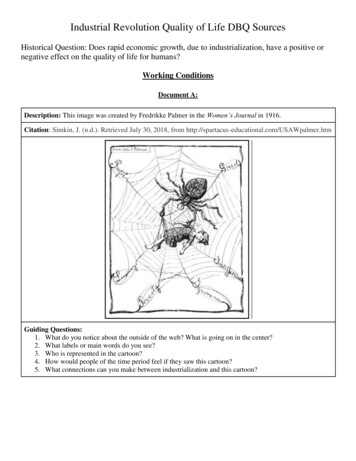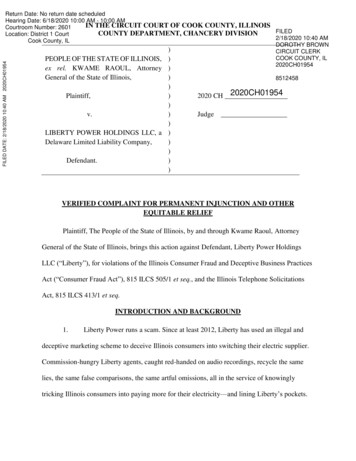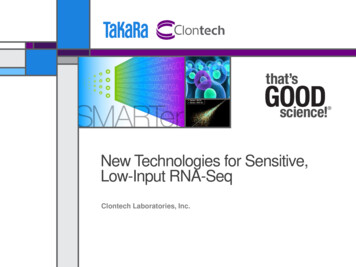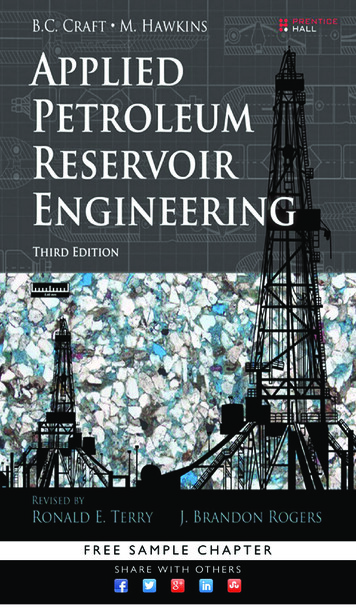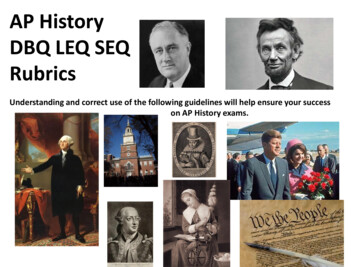
Transcription
AP HistoryDBQ LEQ SEQRubricsUnderstanding and correct use of the following guidelines will help ensure your successon AP History exams.
Rubric for AP U. S. and World HistoryDocument Basic Question (7 points)A. THESIS/CLAIM0-1 ptDBQ1 pt. Responds to the prompt with ahistorically defensible thesis/claim thatestablishes a line of reasoning.To earn this point, the thesis must make a claim that responds to the promptrather than restating or rephrasing the prompt. The thesis must consist of one ormore sentences located in one place, either in the introduction (preferred) or theconclusion.B. CONTEXTUALIZATION0-1 pt1 pt. Describes a broader historicalcontext relevant to the prompt.To earn this point, the response must relate the topic of the prompt to broaderhistorical events, developments, or processes that occur before, during, orcontinue after the time frame of the question. This point is not awarded formerely a phrase or reference.
C. EVIDENCE0-3 ptsEvidence from the Documents1 pt Uses the content of at least 3 documentsto address the topic of the prompt.OR 2 pts Supports an argument in response tothe prompt using at least 6 documents.To earn one point, the response must accurately describe—rather than simplyquote—the content from at least three of the documents.To earn two points, the response must accurately describe—rather than simplyquote—the content from at least 6 documents. In addition, the response must usethe content of the documents to support an argument in response to the prompt.Evidence beyond the Documents1 pt Uses at least one additional piece ofthe specific historical evidence (beyond thatfound in the documents” relevant to anargument about the prompt.To earn this point, the response must describe the evidence and must use morethan a phrase or reference. This additional piece of evidence must be differentfrom the evidence used to earn the point for contextualization.
D. ANALYSIS AND REASONING0-2 pts1 pt For at least 3 documents,explains how or why thedocument’s point of view, purpose,historical situation, and/oraudience is relevant to an argumentabout the prompt.To earn this point, the response must explain how or why (rather than simplyidentifying) the document’s point of view, purpose, historical situation, or audienceis relevant to an argument about the prompt for each of the three documentssourced. (It is better to include all 6 in case you miss the meaning of some.)1pt Demonstrates a complex understanding of the historicaldevelopment that is the focus of the prompt, using evidence tocorroborate, qualify, or modify an argument that address thequestion.A response may demonstrate a complex understanding in a variety of ways, such as:* Explaining nuance of an issue by analyzing multiple variables* Explaining both similarity and difference, or explaining both continuity andchange, or explaining multiple causes, or explaining both cause and effect (cont.)
ANALYSIS AND REASONING CONT. (Do NOT use bullets in AP essays) Explaining relevant and insightful connections within and acrossperiods Confirming the validity of an argument by corroborating multipleperspectives across themes Qualifying or modifying an argument by considering diverse oralternative views or evidenceThis understanding must be part ofthe argument, not merely a phrase orreference.
AP History Long Essay Question Rubric6 pointsA. THESIS/CLAIM 0-1 ptLEQSame as DBQB. CONTEXTUALIZATION 0-1 pt Same as DBQC. EVIDENCE 0-2 pts1 pt Provides specific examples ofevidence relevant to the topic ofthe prompt. OR 2 pts Supports anargument in response to the promptusing specific and relevant examples ofevidence.To earn 1 point, the response must identify specific historical examples ofevidence relevant to the topic of the prompt. To earn 2 points the responsemust use specific historical evidence to support an argument in response tothe prompt.
LEQ Rubric Cont.D. ANALYSIS AND REASONING0-2 pts1 pt. Uses historical reasoning(e.g. comparison, causation, continuity and change overtime) to frame or structure an argument that addressesthe prompt.OR 2 pts. Demonstrates a complexunderstanding of the historical developmentthat is the focus of the prompt, using evidenceto corroborate, qualify, or modify an argumentthat addresses the question.To earn the first point, the response must demonstrate the use ofhistorical reasoning to frame or structure an argument, although thereasoning might be uneven or imbalanced.
LEQ RUBRIC Cont.ANALYSIS AND REASONING 0-2 ptsTo earn the second point, the response must demonstrate acomplex understanding. This can be accomplished in a variety ofways, such as: Explaining nuance of an issue by analyzing multiple variables Explaining both similarity and difference, or explaining bothcontinuity and change, or explaining multiple causes, orexplaining both causes and effects Explaining relevant and insightful connections within and acrossperiods Confirming the validity of an argument by corroboratingmultiple perspectives across themes Qualifying or modifying an argument by considering diverse oralternative views or evidenceThis understanding must be part of the argument,not merely a phrase or reference.
Short Answer Question SAQThe number of required short-answer questions has beenreduced to three.Students will be given a choice among two options for the finalrequired short answer question, each one focusing on a differenttime period.Sample Short-Answer Question Focused on CausationJohn GastAmerican Progress1872Use the image and your knowledge of United States history toanswer parts A, B, and C. (Label each answer: A, B, and C.)A) Describe the point of view reflected in the image regardingONE of the following:MigrationTechnologyAmerican IndiansB) Explain ONE historical cause for the rise of the point of view youidentified in Part A.C) Explain how the point of view you identified in Part A helped toshape ONE specific United States government action between 1845and 1900.
Short-Answer Questions Section I, Part B of the AP U.S. HistoryExam consists of four short-answer questions.Students are required to answer the first and second questions, and then answer either thethird or the fourth question.The first question primarily assesses the practice of analyzing secondary sources, askingstudents to respond in writing to a historian’s argument. This question addresses contentfrom periods 3–8 of the course.The second question primarily assesses either the skill of causation or comparison, and askstudents to respond in writing to a primary source (written text) or to visual sources such asimages, charts, or maps. This question also addresses content from periods 3–8 of thecourse.Students choose to answer either the third or the fourth short-answer questions, which dealwith periods 1–5 or 6–9, respectively. These questions ask students to respond in writingto general propositions about U.S. history, and they primarily assess the same skill, eithercausation or comparison: neither of them will assess the same skill as the second shortanswer question.Each short-answer question asks students to describe examples of historical evidencerelevant to the source or question; these examples can be drawn from the concept outline orfrom other examples explored in depth during classroom instruction.
Example of Short Answer Question Response:SAQWhat was the Compromise of 1850? To what extent was it really a compromise? Whichevents were directly linked to the passage of the compromise?A. In 1849, a sectional rift broke out in Congress over President Zachary Taylor's demandthat California and New Mexico be admitted to the Union as free states--a move thatSoutherners objected to vociferously. Senator Henry Clay attempted to end the rancor byproposing a series of measures that would balance the interests of the free and slavestates. He suggested admitting California as a free state but organize the rest of thesouthwestern territory without restrictions on slavery; require Texas to give up its claimsto parts of New Mexico, but have the federal government assume Texas's preannexationdebt; abolish the slave trade in Washington, D.C., but confirm slavery in the capital; andreinforce Congress's inability to regulate the interstate slave trade and enact a strongerfugitive slave law.B. The measures all passed only because Senator Stephen A. Douglas broke them intotheir component parts and put together a different majority for each one. Becausethere had not been real agreement or compromise on the measures, the question ofslavery in the territories had been avoided only and not solved.C. Within four years, citizens of Kansas and Nebraska territories became involved in highlevels of violence between pro and anti-slavery forces. This made it easier for states tothink about violence as an answer to national issues resulting in war in 1861.
Example of Short Answer Question Response:SAQWhat were the basic issues in the Dred Scott case of 1857? How did the SupremeCourt's decision in the case undermine the Democratic Party? What were effects of thecase?A. Dred Scott was a slave who sued for his own and his family's freedom on thegrounds that his master had taken them to live first in a free state and then in a freeterritory. The Supreme Court's majority decision ruled that Scott could not claimthat his constitutional rights had been violated by his enslavement because no blackperson, whether free or enslaved, was a citizen. The ruling also held that the laws ofScott's home state of Missouri determined his status, that Congress could notprohibit slavery in the territories, and that the Missouri Compromise wasunconstitutional.B. The decision harmed the Democrats by casting doubts on the effectiveness ofpopular sovereignty, the idea that had held the northern and southern factions inthe party together; if Congress could not ban slavery, neither could a territorialgovernment, which was essentially a creation of Congress. Slavery could not beexcluded until a state constitution had been drafted, by which time the systemalready could have taken root.C. The decision led to greater divisions in the nation over slavery. This case is cited asone of the reasons for the acts of secession and then the American Civil War.
Example of Short Answer Question Response:SAQWhat was Stephen A. Douglas's Freeport Doctrine? How did it attempt to addressthe issues raised by the Dred Scott decision? How did Southerners respond to thedoctrine?A. Stephen A. Douglas formulated the Freeport Doctrine at a debate withAbraham Lincoln in 1858. Lincoln attempted to force Douglas to admit thatthe Dred Scott decision had made his solution to slavery in the territories-popular sovereignty--untenable. This occurred in Illinois during the famousLincoln-Douglas Debates in their campaign for the United States Senate.B. Douglas responded with the argument that while settlers could not passlegislation barring slavery, they could keep it out of a territory by refusing toenact protective laws. This action would not permit slaves to be returned, iflost.C. Southerners were appalled by the Freeport Doctrine, which they saw asDouglas's attempt to deny them the victory they had gained with the DredScott decision by allowing settlers to ban slavery from a territory. Increasingly,leaders of the states’ rights movement fanned the flames of dissention basedon the Dred Scott case.
For additional information, resources, and hintshelpful in achieving a qualifying score for college credit:Access: ry-course-and-examdescription Key Concepts Per Time cs-ap-histories.pdf?course ap-united-stateshistory 2017-18 Rubrics for AP History p-united-states-history/course?course apunited-states-history Information and complete copy of an AP U. S. History -united-states-history Student resourcesHernando de Soto, Conquistadorb. 1495 Badajoz, Spaind. 1542 Desha County, ArkansasPocahontas b. 1595 Werowocomoco inpresent-day Tidewater, Virginiad. 1617 Gravesend, England, UKThomas Edison, first electric light bulb1879, Menlo Park, NJ
AP History Long Essay Question Rubric 6 points A. THESIS/CLAIM 0-1 pt Same as DBQ B. CONTEXTUALIZATION 0-1 pt Same as DBQ C. EVIDENCE 0-2 pts 1 pt Provid
